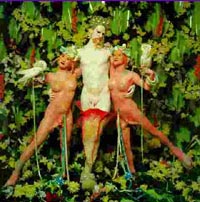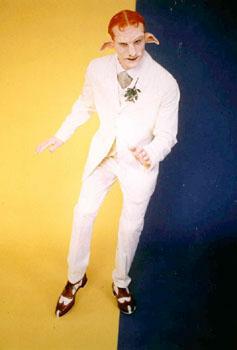L'edicola digitale delle riviste italiane di arte e cultura contemporanea
Intervista (1999 - 2000) Anno IV Numero 20 Ottobre-Novembre 1999
Matthew Barney
Richard Flood
Cremaster 2

Damien Hirst
Gemma De Cruz
n. 23 Summer/Estate 2000
Klein-Dytham
Inokuchi Natsumi
n. 23 Summer/Estate 2000
Ugo Rondinone
n. 21 Gennaio-Febbraio 2000
Production of Production
Tim Griffin e Bennett Simpson
n. 21 Gennaio-Febbraio 2000
Maurizio Cattelan
Maurizio Cattelan
n. 21 Gennaio-Febbraio 2000
Francis Bacon
Michael Peppiat
n. 19 Estate 1999



(english below)
Alcuni anni fa Barney parlò di Cremaster 2 come di un piccolo film, qualcosa dove magari egli avrebbe camminato su un ghiacciaio insieme a un cameraman e avrebbe scolpito una piccola città nel ghiaccio. Non è mai successo.
A un certo punto, sulla strada verso Cremaster 2, Barney legge il libro di Norman Mailer The
Executioner's Song (La canzone del boia) e viene ammaliato dal suo protagonista Gary Gilmore e
dall'ipotesi affascinante che Gilmore possa essere il nipote illegittimo di Harry Houdini.
Fin dall'inizio Barney avvia un'intensa ricerca sulla vita e sulla mitologia che circonda
la figura di Gilmore.
Il risultato costituirà poi la traccia su cui si forma la struttura narrativa di Cremaster 2. Gilmore era un adolescente in cerca di guai che una volta, in libertà vigilata, si trasforma in un adulto assassino che, catturato e condannato, esige di essere, e sarà, giustiziato. Il suo
ragionamento seguiva la logica del suo diritto, come figlio di madre mormone, a espiare i peccati con il sangue per trovare la redenzione. Poiché i due assassinii erano stati commessi nello stato dello Utah, dove era concesso ai condannati a morte di scegliere la modalità della propria esecuzione, Gilmore sceglie di morire fucilato attirando l'attenzione della gente proprio nell'anno del centenario degli Stati Uniti, il 1976. Quella di Gilmore fu la prima sentenza di morte eseguita dopo dieci anni di sospensione, e scatenò una polemica furiosa sull'efficacia della pena capitale, messa in dubbio dal fatto che Gilmore sembrava voler usare la propria condanna per garantirsi la redenzione.
Barney afferra questi elementi, li unisce e li rompe come frammenti di uno specchio in un caleidoscopio. Il fatto che lo Utah sia conosciuto come lo stato "alveare" lo porta a riempire il film con sciami di api, e la gerarchia matriarcale dell'alveare diventa il concetto centrale nell'ellissi del racconto. La famosa telefonata che si dice il cantante country Johnny Cash abbia fatto a Gilmore la notte dell'esecuzione, diventa nel film un assolo heavy metal di batteria.
L'occasionale impotenza di Gilmore è descritta come un'anormalità psicologica per cui una pistola diventa la logica protesi fallica. Il luogo d'incontro tra la nonna di Gilmore, Fay (una spiritista dilettante), e il leggendario mago Houdini diventa in qualche oscuro modo una versione fra futuro e passato della Columbia Expo del 1893 a Chicago, con la sola misteriosa differenza che viene trasportato sul ghiacciaio Columbia in Canada.
I personaggi principali di Cremaster 2 sono la versione allucinata di quelli veri. La nonna paterna, il padre e la madre di Gilmore sono impersonati da "trained waists", persone che allenano i propri corpi a diventare come clessidre attraverso l'uso prolungato di busti. Nella parte di Houdini appare Norman Mailer, l'autore dell'epopea giornalistica che ha ispirato l'incubo tutto americano di Barney. Lo stesso Barney interpreta Gilmore, mentre nel ruolo della fidanzata Nicole Baker appare la cantante country Patty Griffin e Johnny Cash si trasforma in due musicisti rock: Dave Lombardo (ex batterista del gruppo speed-metal Slayer) e Steve Tucker (voce solista per il gruppo death-metal Morbid Angel).
Infine, ecco il paesaggio, nell'epica panoramica delle Montagne Rocciose che sembrano scorrere dalle pianure riarse di sale dello Utah fino ai fluidi congelati dei ghiacciai del Canada.
Barney ha descritto la mistura di paesaggio e biografia come una relazione tra la recessione geologica di un ghiacciaio e il movimento all'indietro per tracciare la genealogia di una famiglia. In Cremaster 2 tanto il paesaggio che i suoi abitanti sono elementi determinanti
del racconto. Il terreno post-glaciale dello Utah è una voragine che succhia e rigetta fuchi dal suo alveare con industriosa costanza. Mentre il ghiacciaio è qualcosa che si rigenera all'infinito e permette la nascita dei miti millenari che stanno al centro della visione di Barney. Cremaster 2 è un racconto popolare cupo con due protagonsiti (Gilmore e Houdini) decisi a sconfiggere il proprio destino, ma nell'universo di Barney il destino è nei geni. Ciò che è predeterminato accade. La politica biologica dell'alveare stabilisce che i fuchi non possano mai superare l'ape regina; essi devono infatti offrirsi in sacrificio affinché l'alveare possa sopravvivere.
Alla fine i destini dei protagonisti di Cremaster 2, Gilmore Houdini, sono lasciati, in opposizione l'uno con l'altro, in uno stato di sospensione: discendente per Houdini e ascendente per Gilmore. In questa loro differenza sta la speranza di un equilibrio.
Matthew Barney ha esordito giovanissimo con mostre a Los Angeles e New York nel 1991. Da allora il suo lavoro affronta le relazioni tra corpo e identità, trasfigurandole in una personale mitologia della cultura americana. Ha esposto presso il San Francisco Museum of Mordern Art, la Fondation Cartier a Parigi, la Tate di Londra e il Whitney di New York. Nel 1992 ha partecipato a Documenta e nel 1993 alla Biennale di Venezia. Il suo nuovo film Cremaster 2 è stato presentato da Pitti Immagine Discovery a Firenze in collaborazione con il Walker Art Center di Minneapolis.
Per le immagini e il testo: Courtesy Pitti Immagine Discovery, Firenze.
------
Several years ago, Barney talked about Cremaster 2 as a small film, something where, perhaps, he just walked out on a glacier with a cameraman and sculpted a little city out of ice. That
didn't happen. Somewhere along the way, Barney read Norman Mailer's The Executioner's Song and
became fascinated with its protagonist, Gary Gilmore, and the possibility that Gilmore was the illegitimate grandson of Harry Houdini. From that starting point Barney began intense research into the life of and mythology surrounding Gilmore. What he discovered forms the loosed narrative
structure of Cremaster 2. Gilmore was an adolescent troublemaker who, on parole, turned into an adult murderer and who, when caught and convicted, demanded to be executed and was. His rationale was his right, as a Mormon mother's son, to Blood Atonement, whereby he could find redemption by
paying for his sins with his life. As Gilmore's two murders took place in Utah, which allowed its death-row inmates to choose their mode of execution, Gilmore elected the right to die by firing squad and captivated public attention when it occurred in the centennial year of 1976. The first
execution in the United States in a decade, it set off a firestorm around the merits of capital punishment, especially as Gilmore appeared to be using it to guarantee his redemption.
Barney takes the facts he gathered and shatters them like the fragmented mirrors in a kaleidoscope. Utah's designation as "the beehive state" literally fills the film with swarms of bees; images of hives abound and the matriarchal hierarchy of the hive becomes a central
conceit of the film's elliptical narrative. A rumored phone call from Johnny Cash to Gilmore on the eve of his execution becomes a heavy metal drum solo. Gilmore's occasional impotency is
depicted as a physiological abnormality for which a gun becomes a logical prosthetic extension. The meeting place for Gilmore's grandmother, Fay (an amateur spiritualist), and Houdini (a legendary magician) somehow becomes a future/past version of the 1893 Columbia Exposition in Chicago, only it has been mysteriously transported to the Columbia Icefield.
Cremaster 2's main characters are hallucinatory versions of very real people, Gilmore's paternal
grandmother, father, and mother are played by "trained waists", people who discipline their bodies to assume hourglass silhouettes through intense, long-term corsetting. Houdini is played
by Norman Mailer, whose documentary epic inspired Barney's very American nightmare. Gilmore, the
subject of Mailer's novel, is played by Barney himself. Johnny Cash morphs into two rock musicians, Dave Lombardo (former drummer for the speed-metal band Slayer) and Steve Tucker (lead singer for the death-metal band Morbid Angel). Gilmore's girlfriend, Nicole Baker, is played by country western singer/songwriter Patty Griffin.
And then there is the landscape - the epic sweep of Rocky Mountains as they course from the arid salt flats of Utah to the frozen liquidity of Canada's glaciers. Barney has described his
blending of landscape and biography as "the relation between the geological recession of a glacier and the backward movement of tracing a family genealogy".
In Cremaster 2, the landscape is as key as its inhabitants in determining the film's narrative. Utah's post-glacial terrain is a void that ingests and excretes the drones from its hive with
industrious dispatch. The Icefield is infinitely regenerative and allows for the fertilization of the millennial myths at the center of Barney's vision.
Cremaster 2 is a very dark folk tale with two protagonists (Gilmore and Houdini) who are determined to outsmart fate, but in Barney's universe, fate is in the genes. What is predetermined is what rules. The biological politics of the hive dictate that the drones are destined never to transcend the Queen and must, in fact, be her sacrificial offerings if the hive
is to survive. In the end, the fates of Cremaster 2's protagonists, Gilmore and Houdini, are left in opposing states of suspension: descending for Houdini and ascending for Gilmore. In their difference lies the promise of balance.
Matthew Barney started his artistic career in 1991 with shows in Los Angeles and New York: since then his work has been dealing with the relationship between body and identity, transfiguring these issues in a personal mythology of American culture. He has exhibited in museums all over
the world, such as the San Francisco Museum of Modern Art, the Cartier Foundation in Paris, the Whitney Museum.
He was one of the partecipants of the Venice Biennial in 1993 and in Documenta in 1992. His new
film Cremaster 2 was presented by Pitti Immagine Discovery in Florence, with the collaboration of the Walker Art Center, Minneapolis. Images and text: Courtesy Pitti Immagine Discovery, Florence.


